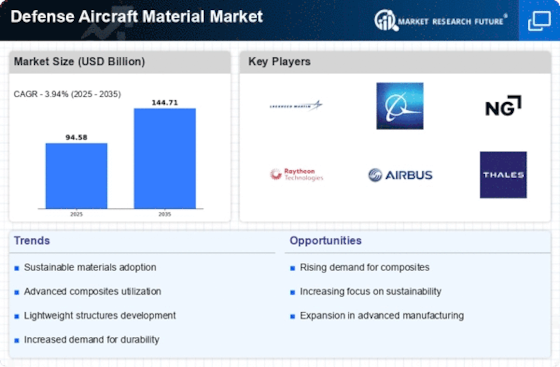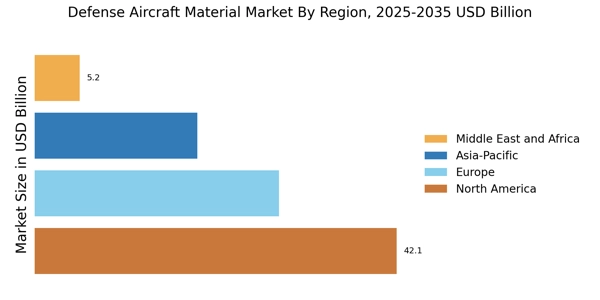Increased Defense Budgets
The Defense Aircraft Material Market is benefiting from increased defense budgets across various nations. Governments are allocating substantial resources to modernize their military fleets, which includes the procurement of advanced aircraft. For instance, recent reports indicate that defense spending in several countries has risen by an average of 3% annually, with a notable focus on upgrading air capabilities. This trend is expected to continue, as geopolitical tensions prompt nations to enhance their defense postures. Consequently, the demand for high-performance materials that can withstand rigorous operational conditions is likely to escalate, thereby driving growth in the Defense Aircraft Material Market.
Technological Advancements in Materials
The Defense Aircraft Material Market is experiencing a surge in technological advancements that enhance material properties and performance. Innovations in composite materials, such as carbon fiber reinforced polymers, are becoming increasingly prevalent. These materials offer superior strength-to-weight ratios, which are critical for modern aircraft design. The market for advanced materials is projected to grow significantly, with estimates suggesting a compound annual growth rate of over 5% in the coming years. This growth is driven by the need for improved fuel efficiency and operational capabilities in defense aircraft. As nations invest in next-generation aircraft, the demand for cutting-edge materials is likely to rise, further propelling the Defense Aircraft Material Market.
Geopolitical Tensions and Military Modernization
The Defense Aircraft Material Market is significantly influenced by geopolitical tensions that drive military modernization efforts. Nations are increasingly investing in advanced aircraft capabilities to address emerging threats and maintain strategic advantages. This trend is evident in various regions, where defense spending is being prioritized to enhance air power. Analysts indicate that The Defense Aircraft Material Market could see a growth trajectory of around 6% annually, largely fueled by these modernization initiatives. As countries seek to upgrade their fleets with state-of-the-art materials, the demand for innovative and resilient materials in the Defense Aircraft Material Market is expected to rise correspondingly.
Rising Demand for Unmanned Aerial Vehicles (UAVs)
The Defense Aircraft Material Market is witnessing a notable shift towards the development and deployment of unmanned aerial vehicles (UAVs). As military operations increasingly incorporate UAVs for surveillance, reconnaissance, and combat roles, the demand for specialized materials tailored for these platforms is on the rise. UAVs require lightweight yet durable materials to optimize flight performance and payload capacity. Market analysts project that the UAV segment will account for a significant portion of the defense aircraft market, with growth rates potentially exceeding 10% over the next five years. This trend underscores the evolving landscape of military aviation and the corresponding implications for the Defense Aircraft Material Market.
Focus on Sustainability and Eco-Friendly Materials
The Defense Aircraft Material Market is gradually shifting towards sustainability, with an emphasis on eco-friendly materials. As environmental concerns gain prominence, defense manufacturers are exploring alternatives that reduce the ecological footprint of aircraft production and operation. This includes the development of recyclable composites and bio-based materials that align with sustainability goals. Reports suggest that the market for sustainable materials in defense applications could grow by approximately 4% annually, reflecting a broader industry trend towards responsible sourcing and manufacturing practices. This focus on sustainability not only addresses regulatory pressures but also enhances the reputation of defense contractors within the Defense Aircraft Material Market.


















Leave a Comment